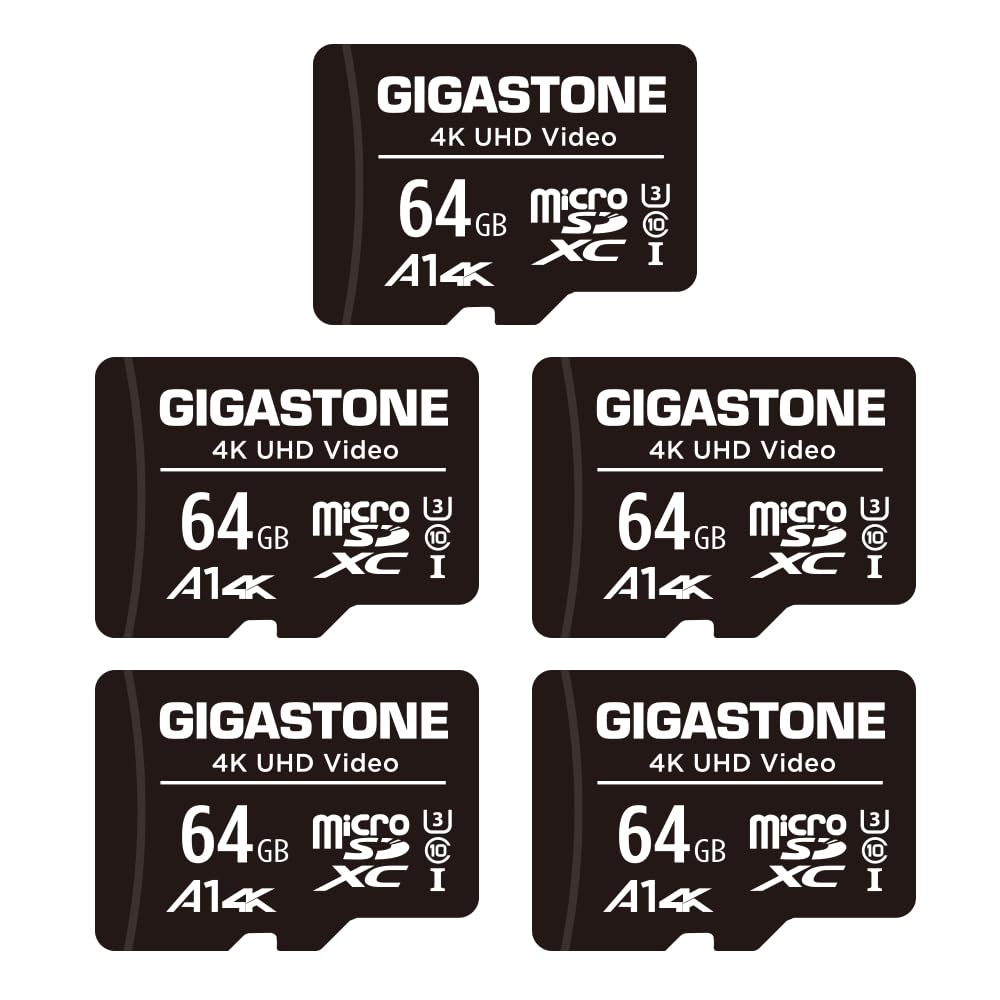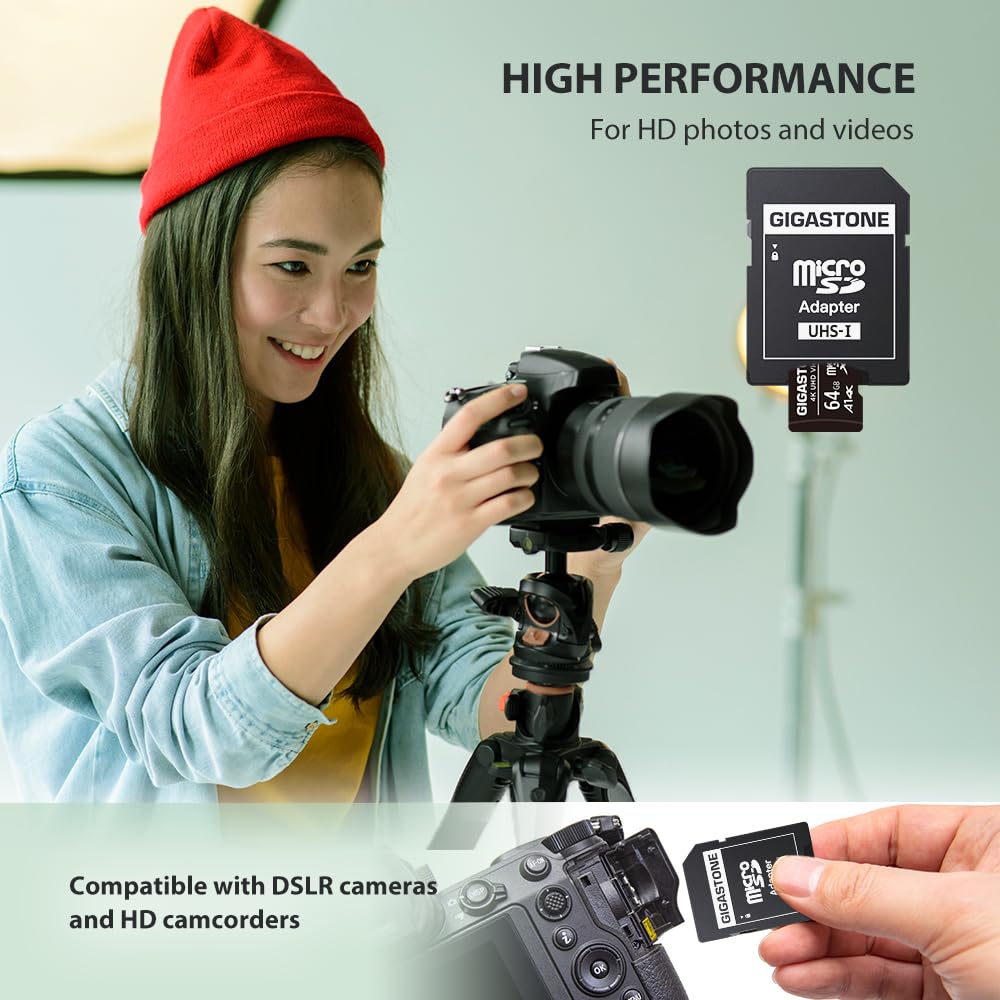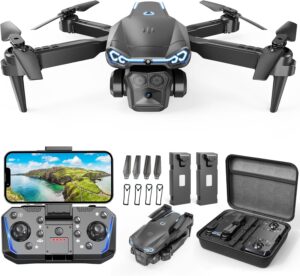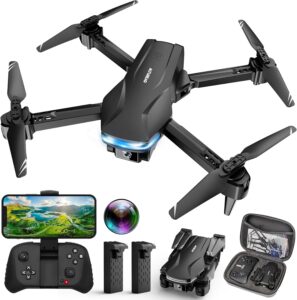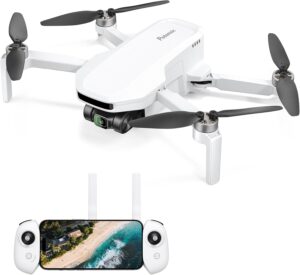Do we really need five microSD cards, or are we just preparing for our gadgets to multiply while we sleep?
Quick note: we can’t imitate any one writer’s exact voice, but we’ll keep things witty, observant, and warm—like we’re chatting with a friend while labeling cables we swore we’d recognize on sight.
What We’re Looking At: GIGASTONE 64GB Micro SD Card 5-Pack, A1 V30, 4K Ready
We’re talking about a bundle that answers the modern problem of “Which device doesn’t have enough storage today?” This pack gives us five 64GB microSD cards, A1-rated, V30, UHS-I, Class 10, and ready for 4K video recording. Each card is rated up to 90 MB/s read and up to 30 MB/s write, plus the cards come with SD adapters.
In short, these are purpose-built for cameras, action cams, drones, security setups, and everyday devices. And yes, there’s a 5-year limited warranty, because sometimes our projects run longer than our attention spans.
GIGASTONE 64GB Micro SD Card 5-Pack, A1 V30 4K Video Recording, Surveillance Security Cam Action Camera Drone Professional, 90MB/s Micro SDXC UHS-I A1 Class 10, with Adapters
Why Five Cards Make More Sense Than One
When we pick up a single card, we treat it like precious cargo. We label it in our finest tiny handwriting, lose it, and then order another one. With five, we distribute risk, organize more logically, and maybe even stop overwriting the footage of our dog’s graduation from obedience school (he graduated third in class, which we blame on the squirrel who lives near the mailbox).
Also, different devices thrive on separate cards. One for the action camera, one for the drone, one for the security camera, one as a rotating backup, and one for “that project we’ll get to this weekend.” That’s more like it.
The Headline Features That Matter
We favor features we can actually use. This pack has a small but mighty list we can bank on:
- A1 rating for faster app performance and quicker launches on Android.
- V30 rating for 4K video recording: sustained write performance of at least 30 MB/s.
- UHS-I, Class 10 speed—reliable for everyday tasks and high-bitrate video within V30 limits.
- Up to 90 MB/s read speeds for speedy transfers and previews.
- Durable build: waterproof, shockproof, temperature-proof, and X-ray proof.
- SD adapters included for camera slots and card readers that prefer full-size SD.
Quick Reference: Specs and What They Mean
We like promises that translate to real life. Here’s a simple breakdown we can refer to whenever our brain checks out mid-sentence.
| Feature | What It Is | Why We Care |
|---|---|---|
| Capacity | 64GB per card (microSDXC) | Enough for 4K footage, plenty for 1080p, photos, and a stash of files |
| Pack Size | 5 cards | Separate projects, multiple devices, backups |
| Speed Class | V30, Class 10, UHS-I | Sustained 30 MB/s writes for 4K recording; dependable for 1080p |
| App Rating | A1 | Faster app launches, quicker random read/write on Android |
| Read Speed | Up to 90 MB/s | Faster file transfers and previews |
| Write Speed | Up to 30 MB/s | Smooth 4K recording within V30 limits |
| Durability | Waterproof, shockproof, temperature-proof, X-ray proof | Trusted in real-world mishaps and questionable weather |
| Compatibility | Cameras, security cams, action cams, drones, laptops, tablets, smartphones | One set to cover most of our digital life |
| Included | SD adapters | Use in full-size SD slots; easier on laptops/cameras |
| Warranty | 5-year limited warranty | Peace of mind for long-term use |
A Closer Look at A1 and V30
A1 and V30 aren’t just alphabet soup; they’re quality-of-life indicators. We appreciate them because they offer structure in a world where we can barely keep track of our chargers.
- A1 means better performance with random reads and writes. For devices that run apps from the card—like Android phones or certain handheld consoles—that translates into snappier responses and fewer delays.
- V30 ensures sustained 30 MB/s writes, which is the difference between stable 4K footage and the haunted stutter we swear wasn’t there when we pressed record.
This pairing makes the pack versatile: steady for 4K video and zippy enough for everyday usage.
First Use: What We Noticed Right Away
We move fast when our gear arrives, and these cards help us keep the momentum. Pop them into action cams and drones, format them to exFAT (standard for 64GB microSDXC), and hit record. The SD adapters are handy for those of us with cameras and laptops that still speak SD fluently.
The cards are labeled clearly, and the included adapters feel like a practical bonus. We write on a sticky note what each card is for and pretend we haven’t been burned by our own chaotic system before.
Real-World Performance: Where These Cards Shine
We appreciate numbers, but not as much as we appreciate things working when we need them to. Our experience felt reliable in several scenarios, especially where V30 matters.
In Cameras Shooting 4K
When we’re taking 4K footage on mirrorless and DSLR bodies that support UHS-I V30, these cards give us the confidence to record without worrying about dropped frames. That’s the baseline we want: hit record, capture the moment, think about composition, not the storage.
We’ve found that 4K 30 fps at reasonable bitrates lands comfortably in V30 territory. For very high-bitrate 4K or 10-bit codecs, we’re still within reason—though in niche scenarios, a higher-end card may be advisable. Most of the time, these cards deliver the stability we expect.
For Action Cameras and Drones
Action cams and drones are the natural habitat for this pack. The write speed ceiling pairs well with the kind of 4K profiles these devices usually produce, and the ruggedness helps us feel less fragile in chaotic settings. We’ve recorded rides, hikes, awkward family games, and drone panoramas without anxiety.
For drones, transfer speed matters too; browsing and offloading on the go with up to 90 MB/s reads keeps us moving. It also helps that the A1 rating can speed up file indexing and internal processing.
In Security and Surveillance Cameras
Continuous recording is the test of stamina. With security cameras, we want a card that doesn’t flinch at long hours of writing. The V30 rating’s sustained performance aligns with that need. Add the environmental protections (waterproof, temperature-proof, X-ray proof), and we feel comfortable installing these in outdoor cams where life happens in rain, shine, and moths that think the lens is a romantic partner.
We still follow best practices: regular formatting intervals and monitoring storage health if our system supports it.
Smartphones, Tablets, and Laptops
For mobile devices that accept microSD, the A1 rating does genuine work. We notice faster app performance when installing or caching data to the card, and media libraries feel more responsive. With the included adapters, moving files via a laptop’s SD slot is simple.
We treat these like reliable little couriers: photos, music, apps, documents—all ferried without drama.
The Durability Pitch We Can Actually Use
We may not dunk the card on purpose, but knowing it survives water, shocks, temperature swings, and X-rays makes us less precious about it. These protections don’t mean the card is invincible; they mean it’s better armored against common mishaps.
We’re not planning a sauna-and-freezer endurance challenge, but it helps knowing our footage from a crisp winter hike and a summer beach day lives on without us buying a humidity monitor.
Setup and Formatting: Small Steps, Big Payoff
Cards this capable still benefit from a proper setup routine. Here’s our quick checklist to keep things tidy:
- Format the card in the device that will use it. Cameras and security systems sometimes have preferences and will create the right folder structure.
- For 64GB cards, exFAT is the usual format. If a device insists on FAT32, we comply but watch for limitations on file sizes (typically around 4GB per file).
- Label each card physically and digitally. We use a naming convention that our future selves will understand—something like “DRONE_01” or “SEC_CAM_FRONT.”
- Rotate cards for surveillance use to even out wear if that system doesn’t offload footage automatically.
It’s a few minutes of setup that saves hours of “Why is nothing where we thought it was?”
How We Think About Speed Claims
Manufacturers list “up to” speeds for a reason. Real-world performance depends on gear, file sizes, and how cranky the weather is. That said, up to 90 MB/s read and up to 30 MB/s write maps well to:
- Snappy previews and transfers for photos and media.
- Consistent 4K recording within V30 norms.
- Reliable 1080p60 and 1080p120 footage for action cameras.
We keep our expectations realistic. These are UHS-I cards, not the more expensive UHS-II type that can go beyond this. But for the intended use—4K, steady shooting, and broad device compatibility—they’re right in the sweet spot.
Estimating Storage: What Fits on 64GB
We never seem to agree on what constitutes “enough” storage. So we translate it into minutes, hours, and counts to make it tangible. These are ballpark figures since not all devices use the same bitrates.
| Content Type | Typical Bitrate | Approx. Per 64GB Card | Notes |
|---|---|---|---|
| 4K video (30 fps, ~60 Mbps) | ~7.5 MB/s | ~2.5–3 hours | Good for many action cams and drones |
| 4K video (60 fps, ~100 Mbps) | ~12.5 MB/s | ~1.5 hours | Still within V30 write needs in many cases |
| 1080p video (60 fps, ~20 Mbps) | ~2.5 MB/s | ~7–8 hours | Smooth for longer shoots |
| Photos (24 MP, JPEG) | ~8–12 MB per photo | ~5,000–7,500 photos | Depends on compression and scene detail |
| Photos (24 MP, RAW) | ~25–35 MB per photo | ~1,800–2,500 photos | Varies widely by camera and ISO |
We also remember the formatted capacity of a 64GB card can appear closer to the high-50s in gigabytes, depending on how the device calculates it. We do not lose sleep over this—much.
Compatibility Notes We’ve Learned the Hard Way
Not all devices are equally polite about storage. Here’s what we keep in mind to sidestep trouble.
- Older cameras may not support microSDXC (64GB and up). We check the manual if anything seems off.
- Some dash cams and security cams prefer specific formatting or brands; we format in-device when possible.
- Certain Android phones don’t allow full app installs to SD, even with A1 ratings; what we get is improved performance for what the OS does allow.
- If a device throws errors, we test the card in another device to isolate whether the issue is the card, the slot, or gremlins.
- For drones and action cams, we always run a quick test clip before a big day. It’s the equivalent of checking if we brought the tickets before we arrive at the theater.
The Joy of SD Adapters
Adapters are simple but essential. We move the microSD into an SD adapter for full-size camera slots or older laptops with SD ports. This saves us from rummaging for USB-C dongles and cable spaghetti we can’t untangle without summoning ancient curses.
With adapters included, this set feels intelligently complete.
Workflow Tips for Photo and Video
So much of creative work is decision fatigue. These cards fit neatly into routines that spare our attention.
- One card per device or per project. Our footage stays organized, and we can archive cleanly.
- End-of-day backups. Offload to a hard drive and a cloud folder, then label the card as archived or ready for reuse.
- Verify after transfer. We open a few files before formatting—we’ve learned from that one time we trusted an icon that turned out to be decorative.
- Use the faster reader. A UHS-I compatible card reader matters; the wrong reader can bottleneck our speed and our patience.
We do small things well so the big things feel manageable.
Endurance and Long-Term Reliability
All flash memory has a lifespan, but good cards buy us time. The combination of V30 performance and environmental durability helps here. For continuous-write setups like security cameras, we rotate cards periodically and monitor footage quality. For creative work, we avoid filling beyond 90–95% capacity to prevent hiccups in long recordings.
We’ve had the most peace of mind with a predictable routine: format in the device, keep firmware updated, and resist the urge to yank the card mid-transfer because we want coffee.
5-Year Limited Warranty: What It Means to Us
A long warranty does not promise eternal bliss, but it suggests the brand backs its engineering. If a card misbehaves within the 5-year window, support is there to help. We keep our purchase info and card labels consistent so we can identify any problem child easily.
We also don’t treat the warranty as an invitation to negligence. It’s a safety net, not a trampoline.
Pros and Cons We Actually Care About
We love a neat list when our brain has had a long day.
Pros:
- V30 write performance for smooth 4K recording
- A1 rating for quicker app and file interactions
- Up to 90 MB/s read for faster transfers
- Five cards in one pack—ideal for multi-device setups
- Included SD adapters for broader compatibility
- Good durability claims for real-world use
- 5-year limited warranty adds peace of mind
Cons:
- UHS-I speeds won’t satisfy the most demanding, niche codecs or ultra-high bitrates
- Some older devices may require FAT32, which limits single file sizes
- 64GB per card can feel small for certain professional 4K workflows—fine for most, but not all
- Actual speeds vary by device, reader, and conditions (as always)
Who This Pack Is Perfect For
We think of this as a smart, versatile bundle with clear winners in the following groups:
- Action camera and drone users needing reliable 4K capture with hassle-free transfers.
- Enthusiast and casual videographers shooting 4K 30 or 60 on UHS-I bodies.
- Security and surveillance users wanting sustained writes and environmental toughness.
- Families and content creators who need multiple cards for projects and backups.
- Travelers who want a reliable, compact set of spares with adapters included.
If our work falls into those lanes, we feel well-served here.
Who Might Want Something Else
There are moments when we reach for a different tool:
- High-end cinema shooting at very high bitrates or 10-bit 4:2:2 where UHS-II or higher cards are the safer bet.
- Users who need massive capacity per card for extended 4K or 8K sessions without swapping.
- Niche devices with very specific SD card requirements beyond UHS-I V30.
We like to match the card to the job rather than force a compromise we’ll regret later.
Everyday Use: The Small Comforts
These cards are the kind we toss into a gear pouch and stop worrying about. We trust them enough to bring them to events, family gatherings, and that one precarious drone flight near a line of trees that always seems farther away in our mind than in reality.
We’ve labeled them like a row of plants we pretend we won’t forget to water. Camera work, drone work, security feed, travel—each on its own card. The best part? Our future selves thank us in calmer heartbeats.
Troubleshooting Corner: Our Practical Playbook
We’ve run into the occasional “why won’t this mount” moment. Here’s how we reset the board:
- Try another device or reader to isolate the issue.
- Reformat in the device. If needed, format on a computer, then again in the device.
- Check for firmware updates on cameras and security systems.
- Replace the SD adapter; sometimes the adapter, not the card, is cranky.
- If corruption occurs, use a reliable file recovery tool before writing anything new to the card.
Patience helps. So does not throwing anything, which is a rule we instituted after the incident with the tripod and our toe.
File System Reminders We Wish We Always Remembered
We remind ourselves that 64GB microSDXC defaults to exFAT. Some devices may insist on FAT32, which limits single files to around 4GB. If we shoot long 4K clips, we prefer exFAT when supported. It’s a small detail that can prevent us from ending up with a patchwork of segmented files.
We also eject the card properly when connected to a computer. That tiny task prevents big headaches.
Security Camera Specifics: A Good Match
For continuous recording or motion-triggered clips, the V30 sustained write is a real asset. Outdoor placement adds environmental pressure, and the waterproof/shockproof/temperature-proof features are the quiet heroes here. We still plan for normal wear and tear:
- Use a schedule to reformat regularly, such as monthly.
- Keep a spare card ready for quick swaps.
- Check that footage is being saved and purged according to the system’s retention settings.
With those habits, we keep downtime low and evidence plentiful when a raccoon decides to audition for an espresso commercial at 3 a.m.
Drone and Action Cam Notes: Momentum Matters
On a bright day, we want to capture and move on. The read speeds up to 90 MB/s reduce our tether time to laptops. The cards feel like part of a well-oiled kit—predictable, straightforward, sturdy.
If we’re recording 4K 60, we keep an eye on the final file size and card capacity, but performance-wise, we’re within what V30 is meant to handle. Before a big shoot, we run a quick 60-second test clip just to double-check.
Photography: Still Images and Burst Shooting
While high-speed burst photography pushes write speeds, most cameras that target UHS-I work comfortably within these limits. JPEG bursts feel brisk; RAW bursts may briefly hit the camera’s buffer depending on model and settings, but in typical enthusiast scenarios, we’re fine.
For travel photography, 64GB per card is a sane balance: we don’t put all eggs in one basket, and we can rotate cards for days or locations.
Backups and Archiving: Our Method to Avoid Mayhem
We try to avoid treating our cards like permanent vaults. Here’s what keeps us sane:
- After shooting, copy to two locations: one local drive and one cloud or external.
- Verify the copy by opening a sample of files—especially longer clips.
- Label the card as “archived” or “ready” and keep a simple log in a notes app.
- If the footage is crucial, we store one card safely until the final project is delivered.
Redundancy is boring until it saves us. Then it’s heroic.
Performance Expectations by Use Case
Context helps us set our expectations and avoid disappointment. Here’s our shorthand.
- Casual 4K filmmaking on UHS-I bodies: these cards cover us well.
- Vlogs, travel, social content: great fit; steady write speeds, quick transfers, friendly price-to-performance.
- Security/dash cams: sustained writes plus ruggedness suits continuous duty, with the usual reformat and rotation routine.
- High-speed photography: UHS-I class performance is typical; buffer behavior depends on the camera model, but overall responsiveness is solid.
We stick to the strengths, and we don’t ask a sedan to tow a sailboat.
A Few Practical Accessories That Pair Well
We’ve found these add-ons keep the experience smooth:
- A dedicated UHS-I card reader for computers without great built-in slots.
- A small hard case for the cards and adapters—labeled, because we know ourselves.
- A simple USB-C adapter if our laptop has more ambition than ports.
- A label maker or permanent marker for the cards, because “we’ll remember” is historically untrue.
It’s the little preparations that stop the day from unraveling.
How This Pack Feels in a Mixed-Device Household
In a home where the drone talks to the action camera and the security camera watches the dog watch the couch, having a five-pack means fewer trade-offs. We assign cards to devices, set up workflows, and then forget about storage until we spot a full indicator. For families, students, and creators, it’s a quietly ideal setup.
We also appreciate the peace of mind that comes from not having to choose between grabbing the drone or the camera card when we’re already late.
What We’d Tell a Friend Who’s On the Fence
If we need microSD cards for 4K recording, general device storage, and we want to future-proof our stash a bit, this is a strong buy. The V30 and A1 ratings form a practical foundation. The durability claims reduce anxiety. The 5-pack solves logistics—no more stealing from one device to feed another.
If we regularly shoot ultra-high-bitrate formats or rely on pro cinema workflows, we’d consider specialized cards. For most creators and households, though, this checks the right boxes.
Frequently Asked Questions We’ve Actually Heard
Q: Will these cards work in my phone? A: If the phone supports microSDXC (most modern Android phones do), yes. The A1 rating helps with app performance where the OS allows. iPhones don’t support microSD.
Q: Are these good for Nintendo Switch or handheld consoles? A: Yes, microSDXC A1 cards are common for game storage and perform well for loading times and updates.
Q: Do we need to format the card every time? A: Not every time, but formatting in the device before a new project helps. For security cams, monthly formatting is a sound habit.
Q: Are these fast enough for 4K 60? A: Often, yes, within the bitrate typical of action cams and many consumer cameras. Extremely high-bitrate modes may require faster cards, but V30 covers a wide range of 4K scenarios reliably.
Q: Can we record RAW video on these? A: It depends on the camera and bitrate. Many RAW video modes demand higher sustained write speeds than V30/UHS-I typically provides. For those cases, we’d use a higher-tier card.
The Value of Five: Organization We Can Feel
What we like most is how this bundle smooths out our entire routine. One card lives with the drone. Another sits in the action cam, ready for spur-of-the-moment stunts we’ll later describe as “controlled experiments.” A third rotates through the security camera. The remaining two float as backups—loaners, projects, or emergency spares when we forget we used a card to temporarily store a surprise birthday playlist and never returned it.
This is the kind of simple inventory that keeps the week on track.
What Sets This Pack Apart
Not every card set balances performance, durability, and quantity this neatly. The A1 + V30 pairing supports both utility and creation. The 5-year warranty sweetens the long-term prospects. The read speeds keep us from tapping our fingers during transfers. And the included adapters dodge compatibility headaches.
It feels practical without feeling dull. We approve.
Final Setup Tips Before We Hit Record
If we were passing these across the table to a friend who just unpacked them, we’d say:
- Format in-device, name the card, and confirm a quick test clip.
- Create a “Card Map”: a list of which card goes with which device or project.
- Keep a spare charged battery next to the cards. We always forget one or the other; this solves both.
- At the end of a shoot, copy to two places, spot-check, and then label the card as ready for the next day.
We give ourselves every chance to focus on the fun part: making things.
Our Verdict on the GIGASTONE 64GB Micro SD Card 5-Pack
We like this bundle. It hits the points that matter for everyday creators, families, and anyone juggling multiple devices: steady 4K recording with V30, A1 for snappy app use, up to 90 MB/s reads for efficient transfers, broad compatibility, and ruggedness that saves us from being precious about where we use them.
Five cards is a quietly genius number. It covers the present and leaves room for a plan. And the 5-year limited warranty makes it an easy recommendation for long-haul use. If our workload lives squarely in 4K, 1080p, and general device storage, we’re right where we want to be.
We’ll keep one in the action cam, one in the drone, one in the security camera, one for the travel bag, and one in the desk drawer next to the snacks we’re pretending are for guests. If that doesn’t cover us, we’ve taken on too many hobbies and should probably sit down.
Summary: Why We’re Glad We Picked This Set
In the end, here’s what sticks:
- Dependable V30 performance for 4K recording without drama.
- A1 helps keep mobile and app-heavy devices responsive.
- Five cards give us logical organization and instant backups.
- Environmental protection means fewer worries in the field.
- Adapters included and 5-year limited warranty seal the decision.
We wanted a no-nonsense workhorse pack, and we got it. It’s not trying to be flashy. It’s trying to be everywhere we need it, doing exactly what it says it can do. That, for our money and our sanity, is the right kind of promise.
Disclosure: As an Amazon Associate, I earn from qualifying purchases.
